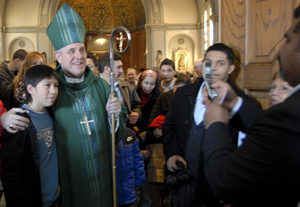
MILWAUKEE — Because Latinos comprise the most rapidly growing segment of the Catholic Church in the United States, Archbishop Jerome E. Listecki made sure that visiting the Latino community in Milwaukee was one of his early priorities.
He visited St. Adalbert Parish on the South Side Sunday, Jan. 17 to celebrate a welcome Mass with the Hispanic community. It was his first opportunity to greet the Milwaukee Archdiocese’s large and growing Hispanic community. In recent years, St. Adalbert, which began as a predominantly Polish parish, has evolved into one of the largest Hispanic parishes in the area.
Although Hispanic presence in the Milwaukee Archdiocese dates to 1926 and the early storefront Our Lady of Guadalupe Church, on 5th and National streets, which served Mexican immigrants, the church is still awakening to the presence and slowly opening its doors, said Fr. Luis Pacheco-Sanchez, one of the first Hispanic priests in the archdiocese and who serves as pastor at St. Adalbert and St. Rafael the Archangel parishes. Today, St. Adalbert totals nearly 8,000 parishioners, about 70 of whom are English-speaking, said Fr. Pacheco.
In recent years, Fr. Eleazar Perez Rodriguez, a priest of the Diocese of Cuauhtémoc-Madera, Chih, Mexico, drew many members to the parish with his charismatic style and personality, but on Oct. 29 Fr. Perez left St. Adalbert to take care of his health, study English and to do personal renovation and spiritual exercises, according to Fr. Pat Heppe in a message dated Nov. 12, 2009 which appeared in several south side parish bulletins in English and Spanish.
With the departure of Fr. Perez and the exit of the Franciscan priests from St. Anthony Parish in late December, the archdiocese’s 30-year-old Hispanic ministry is experiencing changes. Yet, Archbishop Listecki assured the congregation a new leader is on his way, as soon as the right one presents himself.
“I want to make sure it’s the right fit,” said Archbishop Listecki, who was raised in a Polish-Mexican area of Chicago, noting that he loved the faith the two communities share. The Mass included parts in English, Spanish and Polish.
Even with the absence of the well-known priests who had served the Latino community, the focus of Hispanic ministry does not change said Deacon Jorge Benavente, associate for Hispanic Ministry.
In 1983 the U.S. bishops authored a pastoral letter that described the Hispanic community as a blessing and invited all Catholics to welcome their Hispanic brothers and sisters, noted Eva Diaz, archdiocesan coordinator for intercultural ministries, in an e-mail. The National Pastoral Plan for the Ministry developed in 1987 is one of the major achievements of the church in recent times, she said.
The bishops outlined five categories for the focus of Hispanic ministry, according to Deacon Benavente. These include: Catholic marriage, faith formation and sacramental practice, life and dignity of the human person, promotion for the vocation to priesthood and the consecrated, and cultural diversity.
“Hispanic ministry is not only Hispanic, but a bridge with other ethnic groups,” he said. “We are not an isolated church. It is part of the church of Milwaukee as well as African, Hmong, Asian. We have to work together.”
As the leader of a church dominated by recent Hispanic immigrants, Fr. Pacheco said that he promotes assimilation and integration – each respecting their own cultures and respecting the culture in which they live.
However, the churches still deal with problems such as immigration, discrimination and funding according to Deacon Benavente.
“We are working without any resources. But the good thing is that we have more people, but even without resources we have to help these people,” he said.
Deacon Benavente and Fr. Pacheco agreed that one must recognize the Hispanic population is much more than Mexican; it includes people from other areas of Central America, South America, Puerto Rico, Cuba and Spain. Deacon Benavente said that these areas have strong Catholic roots and many parishioners, although they may leave the church at some point, come back later in life and strengthen a parish.
“These people come back to the community in which they grew up and make up a part of a more stable Hispanic church,” said Fr. Pacheco. “As the younger generation grows, we will see a church that is stronger and more stable.”
The second and third generations of Hispanics are important to the community, according to Deacon Benavente, noting that 20 or 30 years ago people were reluctant to participate, but that now all were working together.
Fr. Pacheco noted that since the departure of Fr. Perez, St. Adalbert has not seen a decline in parishioners.
